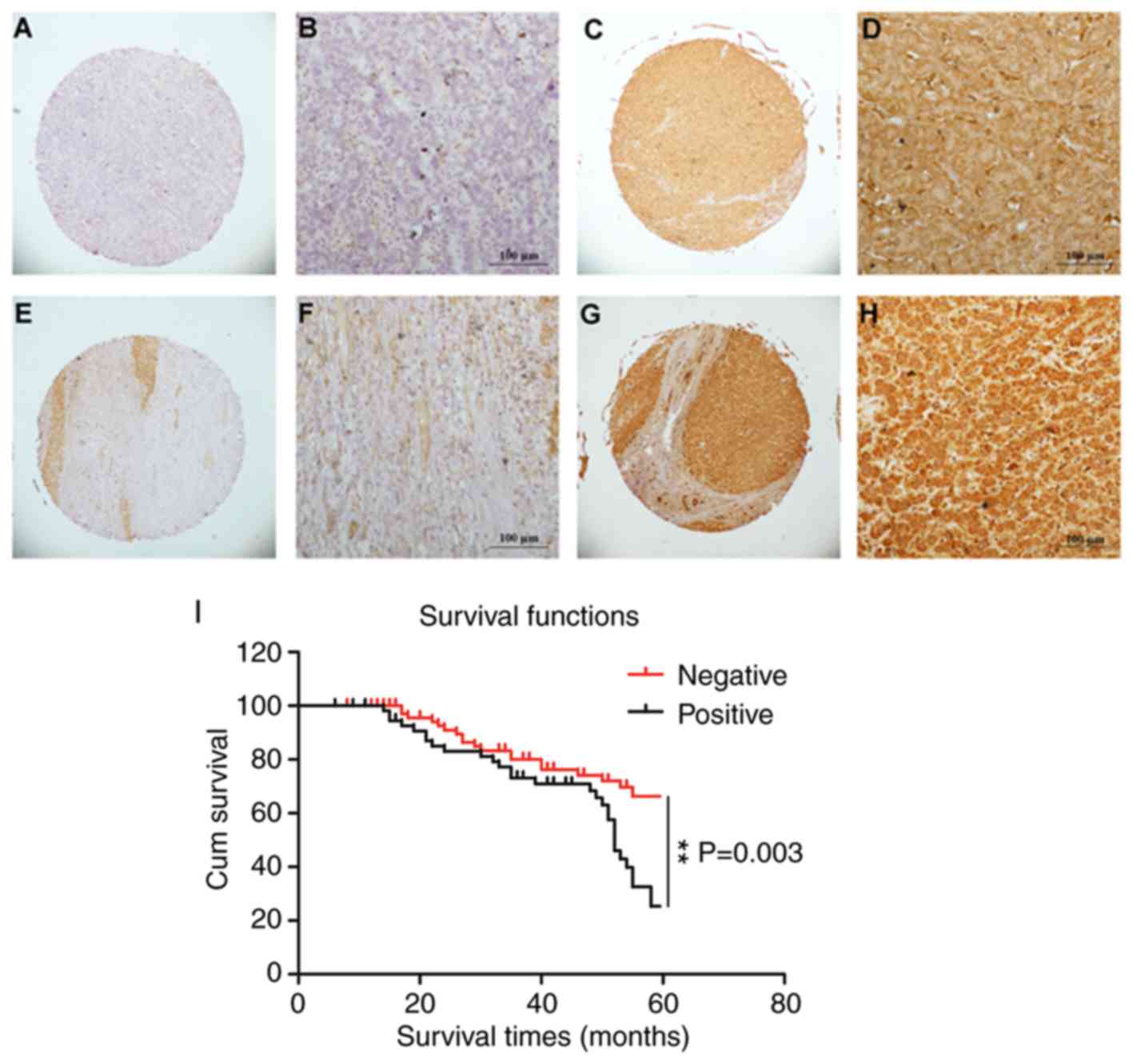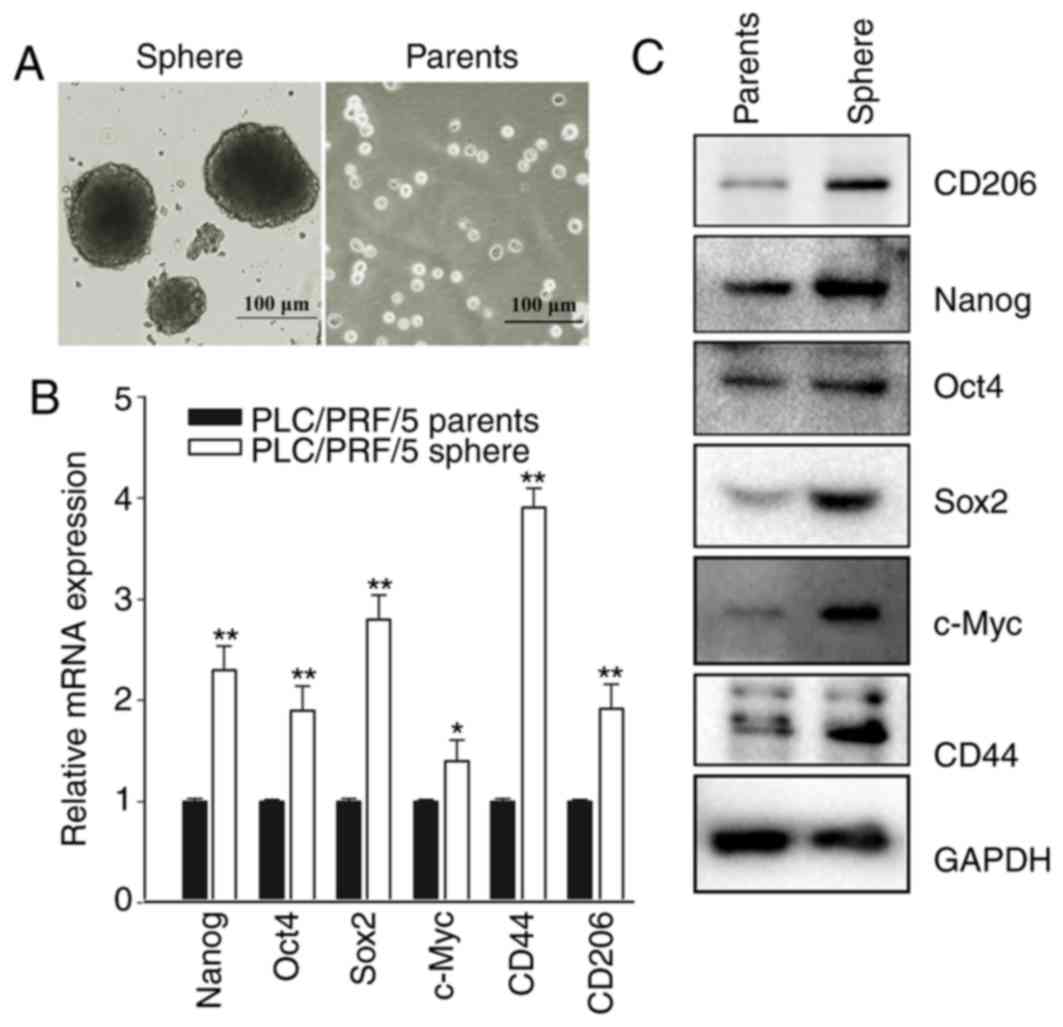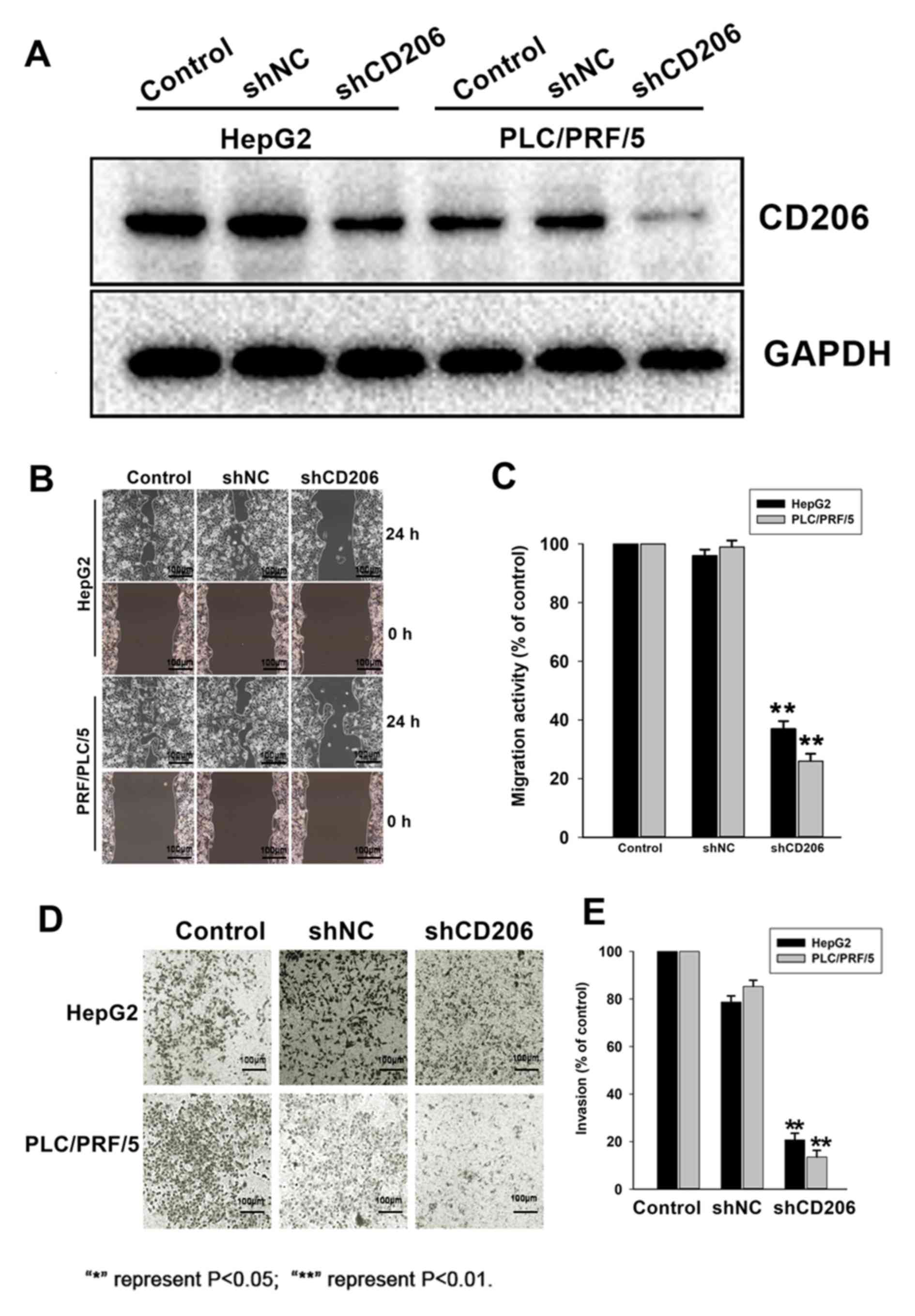|
1
|
Ghouri YA, Mian I and Rowe JH: Review of
hepatocellular carcinoma: Epidemiology, etiology, and
carcinogenesis. J Carcinog. 16:12017. View Article : Google Scholar : PubMed/NCBI
|
|
2
|
Altekruse SF, Henley SJ, Cucinelli JE and
McGlynn KA: Changing hepatocellular carcinoma incidence and liver
cancer mortality rates in the United States. Am J Gastroenterol.
109:542–553. 2014. View Article : Google Scholar : PubMed/NCBI
|
|
3
|
Ferlay J, Soerjomataram I, Dikshit R, Eser
S, Mathers C, Rebelo M, Parkin DM, Forman D and Bray F: Cancer
incidence and mortality worldwide: Sources, methods and major
patterns in GLOBOCAN 2012. Int J Cancer. 136:E359–E386. 2015.
View Article : Google Scholar : PubMed/NCBI
|
|
4
|
Tsai WC, Kung PT, Wang YH, Kuo WY and Li
YH: Influence of the time interval from diagnosis to treatment on
survival for early-stage liver cancer. PLoS One. 13:e01995322018.
View Article : Google Scholar : PubMed/NCBI
|
|
5
|
Ronot M, Clift AK, Vilgrain V and Frilling
A: Functional imaging in liver tumours. J Hepatol. 65:1017–1030.
2016. View Article : Google Scholar : PubMed/NCBI
|
|
6
|
Marrero JA, Ahn J and Rajender Reddy K;
Americal College of Gastroenterology, : ACG clinical guideline: The
diagnosis and management of focal liver lesions. Am J
Gastroenterol. 109:1328–1348. 2014. View Article : Google Scholar : PubMed/NCBI
|
|
7
|
Elsayes KM, Hooker JC, Agrons MM, Kielar
AZ, Tang A, Fowler KJ, Chernyak V, Bashir MR, Kono Y, Do RK, et al:
2017 version of LI-RADS for CT and MR Imaging: An update.
Radiographics. 37:1994–2017. 2017. View Article : Google Scholar : PubMed/NCBI
|
|
8
|
Ryerson AB, Eheman CR, Altekruse SF, Ward
JW, Jemal A, Sherman RL, Henley SJ, Holtzman D, Lake A, Noone AM,
et al: Annual report to the nation on the status of cancer,
1975–2012, featuring the increasing incidence of liver cancer.
Cancer. 122:1312–1337. 2016. View Article : Google Scholar : PubMed/NCBI
|
|
9
|
Sia D, Villanueva A, Friedman SL and
Llovet JM: Liver cancer cell of origin, molecular class, and
effects on patient prognosis. Gastroenterology. 152:745–761. 2017.
View Article : Google Scholar : PubMed/NCBI
|
|
10
|
Bhoori S and Mazzaferro V: Current
challenges in liver transplantation for hepatocellular carcinoma.
Best Pract Res Clin Gastroenterol. 28:867–879. 2014. View Article : Google Scholar : PubMed/NCBI
|
|
11
|
Chen W, Fan W, Ru G, Huang F, Lu X, Zhang
X, Mou X and Wang S: Gemcitabine combined with an engineered
oncolytic vaccinia virus exhibits a synergistic suppressive effect
on the tumor growth of pancreatic cancer. Oncol Rep. 41:67–76.
2019.PubMed/NCBI
|
|
12
|
Staines K, Hunt LG, Young JR and Butter C:
Evolution of an expanded mannose receptor gene family. PLoS One.
9:e1103302014. View Article : Google Scholar : PubMed/NCBI
|
|
13
|
Lee SH, Charmoy M, Romano A, Paun A,
Chaves MM, Cope FO, Ralph DA and Sacks DL: Mannose receptor high,
M2 dermal macrophages mediate nonhealing Leishmania major infection
in a Th1 immune environment. J Exp Med. 215:357–375. 2018.
View Article : Google Scholar : PubMed/NCBI
|
|
14
|
Peng H, Geil Nickell CR, Chen KY, McClain
JA and Nixon K: Increased expression of M1 and M2 phenotypic
markers in isolated microglia after four-day binge alcohol exposure
in male rats. Alcohol. 62:29–40. 2017. View Article : Google Scholar : PubMed/NCBI
|
|
15
|
Salmi M, Karikoski M, Elima K, Rantakari P
and Jalkanen S: CD44 binds to macrophage mannose receptor on
lymphatic endothelium and supports lymphocyte migration via
afferent lymphatics. Circ Res. 112:1577–1582. 2013. View Article : Google Scholar : PubMed/NCBI
|
|
16
|
van Lessen M, Shibata-Germanos S, van
Impel A, Hawkins TA, Rihel J and Schulte-Merker S: Intracellular
uptake of macromolecules by brain lymphatic endothelial cells
during zebrafish embryonic development. Elife. 6(pii): e259322017.
View Article : Google Scholar : PubMed/NCBI
|
|
17
|
Azad AK, Rajaram MV, Metz WL, Cope FO,
Blue MS, Vera DR and Schlesinger LS: γ-Tilmanocept, a new
radiopharmaceutical tracer for cancer sentinel lymph nodes, binds
to the mannose receptor (CD206). J Immunol. 195:2019–2029. 2015.
View Article : Google Scholar : PubMed/NCBI
|
|
18
|
Andersen MN, Andersen NF, Rodgaard-Hansen
S, Hokland M, Abildgaard N and Moller HJ: The novel biomarker of
alternative macrophage activation, soluble mannose receptor
(sMR/sCD206): Implications in multiple myeloma. Leuk Res.
39:971–975. 2015. View Article : Google Scholar : PubMed/NCBI
|
|
19
|
Bianchi G and Munshi NC: Pathogenesis
beyond the cancer clone(s) in multiple myeloma. Blood.
125:3049–3058. 2015. View Article : Google Scholar : PubMed/NCBI
|
|
20
|
Kume H, Muraoka S, Kuga T, Adachi J,
Narumi R, Watanabe S, Kuwano M, Kodera Y, Matsushita K, Fukuoka J,
et al: Discovery of colorectal cancer biomarker candidates by
membrane proteomic analysis and subsequent verification using
selected reaction monitoring (SRM) and tissue microarray (TMA)
analysis. Mol Cell Proteomics. 13:1471–1484. 2014. View Article : Google Scholar : PubMed/NCBI
|
|
21
|
Rodgaard-Hansen S, Rafique A, Christensen
PA, Maniecki MB, Sandahl TD, Nexo E and Moller HJ: A soluble form
of the macrophage-related mannose receptor (MR/CD206) is present in
human serum and elevated in critical illness. Clin Chem Lab Med.
52:453–461. 2014. View Article : Google Scholar : PubMed/NCBI
|
|
22
|
Sun C, Shui B, Zhao W, Liu H, Li W, Lee
JC, Doran R, Lee FK, Sun T, Shen QS, et al: Central role of
IP3R2-mediated Ca2+ oscillation in self-renewal of liver
cancer stem cells elucidated by high-signal ER sensor. Cell Death
Dis. 10:3962019. View Article : Google Scholar : PubMed/NCBI
|
|
23
|
Cao J, Zhao M, Liu J, Zhang X, Pei Y, Wang
J, Yang X, Shen B and Zhang J: RACK1 promotes self-renewal and
chemoresistance of cancer stem cells in human hepatocellular
carcinoma through stabilizing nanog. Theranostics. 9:811–828. 2019.
View Article : Google Scholar : PubMed/NCBI
|
|
24
|
Yang X, Li S, Wang H, Chen W, Mou X and
Wang S: Expression of coxsackie and adenovirus receptor is
correlated with inferior prognosis in liver cancer patients. Oncol
Lett. 17:2485–2490. 2019.PubMed/NCBI
|
|
25
|
Petrizzo A and Buonaguro L: Application of
the Immunoscore as prognostic tool for hepatocellular carcinoma. J
Immunother Cancer. 4:712016. View Article : Google Scholar : PubMed/NCBI
|
|
26
|
Luo Y, Pandey A, Ghasabeh MA, Pandey P,
Varzaneh FN, Zarghampour M, Khoshpouri P, Ameli S, Li Z, Hu D and
Kamel IR: Prognostic value of baseline volumetric multiparametric
MR imaging in neuroendocrine liver metastases treated with
transarterial chemoembolization. Eur Radiol. Mar 15–2019.doi:
10.1007/s00330-019-06100-3 (Epub ahead of print). View Article : Google Scholar
|
|
27
|
Colecchia A, Scaioli E, Montrone L,
Vestito A, Di Biase AR, Pieri M, D'Errico-Grigioni A,
Bacchi-Reggiani ML, Ravaioli M, Grazi GL and Festi D: Pre-operative
liver biopsy in cirrhotic patients with early hepatocellular
carcinoma represents a safe and accurate diagnostic tool for tumour
grading assessment. J Hepatol. 54:300–305. 2011. View Article : Google Scholar : PubMed/NCBI
|
|
28
|
Kong M and Hong SE: Optimal follow-up
duration for evaluating objective response to radiotherapy in
patients with hepatocellular carcinoma: A retrospective study. Chin
J Cancer. 34:79–85. 2015. View Article : Google Scholar : PubMed/NCBI
|
|
29
|
Gan W, Zhang MX, Wang JX, Fu YP, Huang JL,
Yi Y, Jing CY, Fan J, Zhou J and Qiu SJ: Prognostic impact of
lactic dehydrogenase to albumin ratio in hepatocellular carcinoma
patients with Child-Pugh I who underwent curative resection: A
prognostic nomogram study. Cancer Manag Res. 10:5383–5394. 2018.
View Article : Google Scholar : PubMed/NCBI
|
|
30
|
Couri T and Pillai A: Goals and targets
for personalized therapy for HCC. Hepatol Int. 13:125–137. 2019.
View Article : Google Scholar : PubMed/NCBI
|
|
31
|
Zhu R, Huang H, Zhang H, Wang Z, Hu X,
Zhai W, Lin Y, Wang J and Zhu H: Prognostic analysis in chronic
hepatitis B patients: A retrospective study of 216 cases about
Scheuer scores, in situ expression of viral antigens and tissue
hepatitis B virus DNA levels. Liver Int. 26:82–89. 2006. View Article : Google Scholar : PubMed/NCBI
|
|
32
|
Zhu AX, Kang YK, Yen CJ, Finn RS, Galle
PR, Llovet JM, Assenat E, Brandi G, Pracht M, Lim HY, et al:
Ramucirumab after sorafenib in patients with advanced
hepatocellular carcinoma and increased alpha-fetoprotein
concentrations (REACH-2): A randomised, double-blind,
placebo-controlled, phase 3 trial. Lancet Oncol. 20:282–296. 2019.
View Article : Google Scholar : PubMed/NCBI
|
|
33
|
Shim JH, Yoon DL, Han S, Lee YJ, Lee SG,
Kim KM, Lim YS, Lee HC, Chung YH and Lee YS: Is serum
alpha-fetoprotein useful for predicting recurrence and mortality
specific to hepatocellular carcinoma after hepatectomy? A test
based on propensity scores and competing risks analysis. Ann Surg
Oncol. 19:3687–3696. 2012. View Article : Google Scholar : PubMed/NCBI
|
|
34
|
Zhong M, Zhong C, Cui W, Wang G, Zheng G,
Li L, Zhang J, Ren R, Gao H, Wang T, et al: Induction of
tolerogenic dendritic cells by activated TGF-beta/Akt/Smad2
signaling in RIG-I-deficient stemness-high human liver cancer
cells. BMC Cancer. 19:4392019. View Article : Google Scholar : PubMed/NCBI
|
|
35
|
Wei X, You X, Zhang J and Zhou C:
MicroRNA-1305 inhibits the stemness of LCSCs and Tumorigenesis by
repressing the UBE2T-dependent Akt-signaling pathway. Mol Ther
Nucleic Acids. 16:721–732. 2019. View Article : Google Scholar : PubMed/NCBI
|
|
36
|
Bamodu OA, Kuo KT, Yuan LP, Cheng WH, Lee
WH, Ho YS, Chao TY and Yeh CT: HDAC inhibitor suppresses
proliferation and tumorigenicity of drug-resistant chronic myeloid
leukemia stem cells through regulation of hsa-miR-196a targeting
BCR/ABL1. Exp Cell Res. 370:519–530. 2018. View Article : Google Scholar : PubMed/NCBI
|
|
37
|
Choi HS, Kim JH, Kim SL, Deng HY, Lee D,
Kim CS, Yun BS and Lee DS: Catechol derived from aronia juice
through lactic acid bacteria fermentation inhibits breast cancer
stem cell formation via modulation Stat3/IL-6 signaling pathway.
Mol Carcinog. 57:1467–1479. 2018. View
Article : Google Scholar : PubMed/NCBI
|
|
38
|
Mani SK, Zhang H, Diab A, Pascuzzi PE,
Lefrancois L, Fares N, Bancel B, Merle P and Andrisani O:
EpCAM-regulated intramembrane proteolysis induces a cancer stem
cell-like gene signature in hepatitis B virus-infected hepatocytes.
J Hepatol. 65:888–898. 2016. View Article : Google Scholar : PubMed/NCBI
|
|
39
|
Liu M, Jiang L and Guan XY: The genetic
and epigenetic alterations in human hepatocellular carcinoma: A
recent update. Protein Cell. 5:673–691. 2014. View Article : Google Scholar : PubMed/NCBI
|
|
40
|
Orcutt ST and Anaya DA: Liver resection
and surgical strategies for management of primary liver cancer.
Cancer Control. 25:10732748177446212018. View Article : Google Scholar : PubMed/NCBI
|
|
41
|
Scodeller P, Simon-Gracia L, Kopanchuk S,
Tobi A, Kilk K, Saalik P, Kurm K, Squadrito ML, Kotamraju VR,
Rinken A, et al: Precision targeting of tumor macrophages with a
CD206 binding peptide. Sci Rep. 7:146552017. View Article : Google Scholar : PubMed/NCBI
|
|
42
|
Maehara O, Ohnishi S, Asano A, Suda G,
Natsuizaka M, Nakagawa K, Kobayashi M, Sakamoto N and Takeda H:
Metformin regulates the expression of CD133 through the AMPK-CEBPβ
pathway in hepatocellular carcinoma cell lines. Neoplasia.
21:545–556. 2019. View Article : Google Scholar : PubMed/NCBI
|
|
43
|
Palla AR, Piazzolla D, Abad M, Li H,
Dominguez O, Schonthaler HB, Wagner EF and Serrano M: Reprogramming
activity of NANOGP8, a NANOG family member widely expressed in
cancer. Oncogene. 33:2513–2519. 2014. View Article : Google Scholar : PubMed/NCBI
|
|
44
|
Jerabek S, Merino F, Scholer HR and
Cojocaru V: OCT4: Dynamic DNA binding pioneers stem cell
pluripotency. Biochim Biophys Acta. 1839:138–154. 2014. View Article : Google Scholar : PubMed/NCBI
|
|
45
|
Guvench O: Revealing the mechanisms of
protein disorder and N-glycosylation in CD44-hyaluronan binding
using molecular simulation. Front Immunol. 6:3052015. View Article : Google Scholar : PubMed/NCBI
|
|
46
|
Yoshida GJ: Emerging roles of Myc in stem
cell biology and novel tumor therapies. J Exp Clin Cancer Res.
37:1732018. View Article : Google Scholar : PubMed/NCBI
|
|
47
|
Suzuki Y, Haraguchi N, Takahashi H, Uemura
M, Nishimura J, Hata T, Takemasa I, Mizushima T, Ishii H, Doki Y,
et al: SSEA-3 as a novel amplifying cancer cell surface marker in
colorectal cancers. Int J Oncol. 42:161–167. 2013.PubMed/NCBI
|
|
48
|
Botchkina GI, Zuniga ES, Das M, Wang Y,
Wang H, Zhu S, Savitt AG, Rowehl RA, Leyfman Y, Ju J, et al:
New-generation taxoid SB-T-1214 inhibits stem cell-related gene
expression in 3D cancer spheroids induced by purified colon
tumor-initiating cells. Mol Cancer. 9:1922010. View Article : Google Scholar : PubMed/NCBI
|
|
49
|
Kanda T, Goto T, Hirotsu Y, Moriyama M and
Omata M: Molecular mechanisms driving progression of liver
cirrhosis towards hepatocellular carcinoma in chronic Hepatitis B
and C infections: A review. Int J Mol Sci. 20(pii): E13582019.
View Article : Google Scholar : PubMed/NCBI
|
|
50
|
Zahra M, Azzazy H and Moustafa A:
Transcriptional regulatory networks in Hepatitis C virus-induced
hepatocellular carcinoma. Sci Rep. 8:142342018. View Article : Google Scholar : PubMed/NCBI
|

















